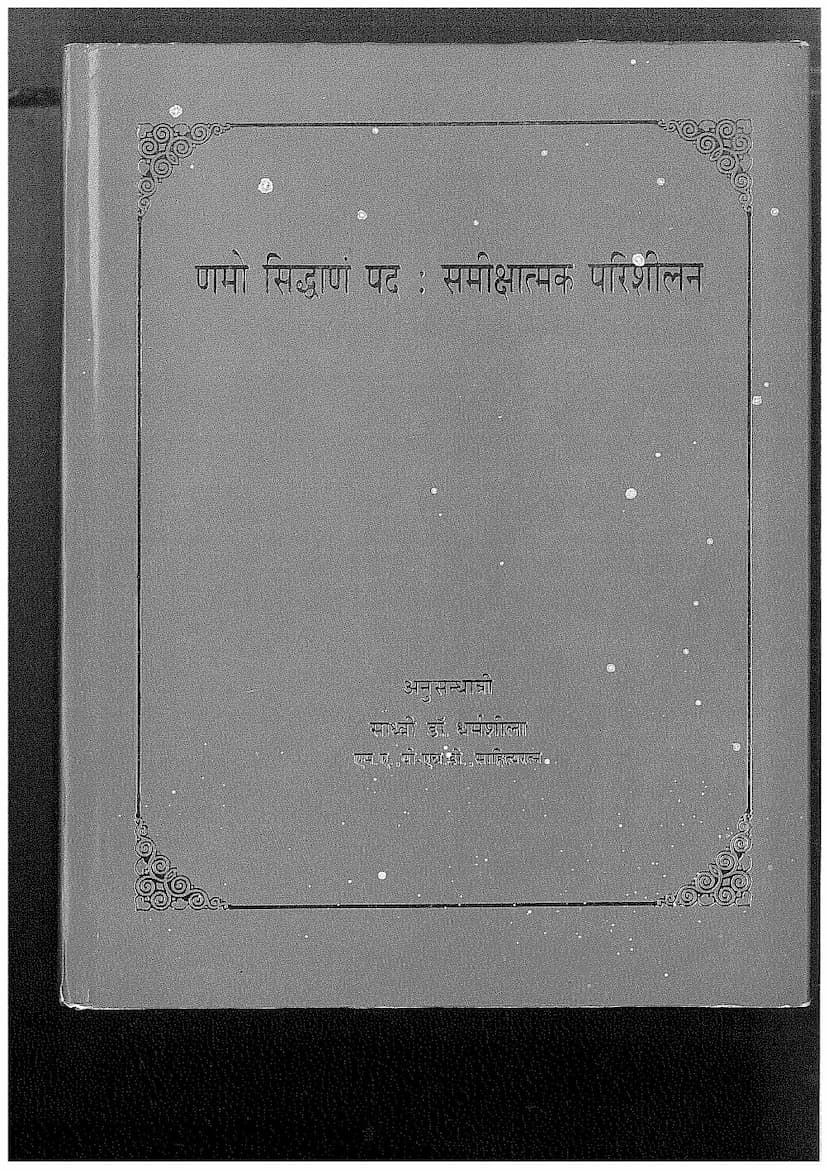Namo Siddhanam Pad Samikshatmak Parishilan
Added to library: September 2, 2025

Summary
Here is a comprehensive summary of the Jain text "Namo Siddhanam Pad Samikshatmak Parishilan" by Sadhvi Dr. Dharamsheelashreeji, based on the provided pages:
Book Title: Namo Siddhanam Pad: Samikshatmak Parishilan (A Critical Study of the Phrase "Namo Siddhanam")
Author: Sadhvi Dr. Dharamsheelashreeji (M.A., Ph.D., Sahityaratna)
Publisher: Ujjwal Dharm Trust, Mumbai and Shri S. S. Jain Sangh, Ayyanavaram, Chennai
Introduction and Context:
The book is a scholarly and in-depth study of the phrase "Namo Siddhanam" from the revered Namokar Mahamantra in Jainism. It was published on the auspicious occasion of the 2600th birth anniversary of Lord Mahavir. The author, Sadhvi Dr. Dharamsheelashreeji, is a learned ascetic who has dedicated her life to the pursuit of spiritual knowledge and practice. The work is presented as a comprehensive research thesis, likely for a D.Litt. degree, reflecting her profound scholarship and commitment to Jain philosophy.
Core Subject and Significance:
The central theme of the book is the critical examination of the concept of "Siddhas" (the perfected souls) within Jainism, as represented by the phrase "Namo Siddhanam" (Salutations to the Siddhas). The study delves into the philosophical, historical, and practical dimensions of Siddhahood as a supreme goal for every Jain practitioner.
Key Areas Explored:
The book systematically breaks down the concept of Siddhahood and its connection to the Namokar Mahamantra, covering a wide range of topics:
-
Jain Dharma, Philosophy, and Literature: The initial chapters lay the foundation by discussing Jainism's core principles (ahimsa, anekant, aparigraha), its place among world religions, the significance of the Namokar Mahamantra, and the vastness and importance of Jain literature, including the Anga and Upanga Agamas, and post-Sutras Jain works. It highlights the Jain tradition's emphasis on 'achara' (conduct) and the living nature of its spiritual lineage.
-
The Namokar Mahamantra and Siddha-Aradhana: The book extensively analyzes the Namokar Mahamantra, its origin, power, and the methods of its adoration (Japa Vidhi). It explores the spiritual and mundane benefits derived from chanting and meditating on the mantra, emphasizing its role in attaining peace and spiritual upliftment. The analysis includes various aspects like mantra's vibrational nature, its connection to inner consciousness, and its efficacy through different practices.
-
Siddhahood in Agamas and Later Texts: A significant portion of the book is dedicated to the detailed exposition of the concept of Siddhas as presented in the Jain Agamas (like Acharanga, Sutrakritanga, Sthānānga, Samavāyānga, Vyākhyāprajñapti, etc.) and subsequent Jain literature. It examines:
- The nature of Siddhas: Their characteristics, qualities, location (Siddhashila), their eternal and blissful state, and what happens after liberation.
- Paths to Siddhahood: The book discusses the role of gunasthanas (stages of spiritual development) as a ladder to Siddhahood, the importance of 'achara' (conduct), 'samyam' (restraint), and 'tapas' (austerities).
- Various classifications of Siddhas: Including those attained through different lineages, genders, spiritual paths, and states.
- Comparison with other Philosophies: The text touches upon the concept of liberation or ultimate reality in Vedanta, Sankhya, Yoga, and Buddhism, offering a comparative analysis.
-
Jain Yoga and Siddhahood: The book explores the connection between Jain philosophical principles and Yoga as a practical path to spiritual realization. It highlights how Jain teachings integrate aspects of Yoga, such as the importance of ethical conduct (yamas and niyamas), posture (asana), breath control (pranayama), and meditation for achieving the ultimate goal of Siddhahood.
-
The Concept of 'Namo' and Devotion: The text emphasizes the significance of the word 'Namo' (salutation) in the mantra, signifying humility, respect, and surrender to the Siddhas. It explains how this devotional aspect is crucial for spiritual progress.
-
Theological and Philosophical Underpinnings: The book examines concepts like 'dravya' (substance), 'pudgala' (matter), 'karma,' and their role in the soul's journey towards liberation. It discusses the significance of 'Nischaya Naya' (ultimate truth) and 'Vyavahara Naya' (conventional truth) in understanding spiritual concepts.
-
Theological and Philosophical Underpinnings: The book examines concepts like 'dravya' (substance), 'pudgala' (matter), 'karma,' and their role in the soul's journey towards liberation. It discusses the significance of 'Nischaya Naya' (ultimate truth) and 'Vyavahara Naya' (conventional truth) in understanding spiritual concepts.
-
Theological and Philosophical Underpinnings: The book examines concepts like 'dravya' (substance), 'pudgala' (matter), 'karma,' and their role in the soul's journey towards liberation. It discusses the significance of 'Nischaya Naya' (ultimate truth) and 'Vyavahara Naya' (conventional truth) in understanding spiritual concepts.
-
Theological and Philosophical Underpinnings: The book examines concepts like 'dravya' (substance), 'pudgala' (matter), 'karma,' and their role in the soul's journey towards liberation. It discusses the significance of 'Nischaya Naya' (ultimate truth) and 'Vyavahara Naya' (conventional truth) in understanding spiritual concepts.
Key Contributions and Focus:
- Comprehensive Analysis: The book offers a systematic and detailed analysis of the Siddha-pada, drawing from a vast array of Jain scriptures and philosophical texts.
- Interdisciplinary Approach: It connects Jain philosophy with broader Indian philosophical traditions, including Vedanta, Sankhya, and Yoga, highlighting both similarities and unique Jain perspectives.
- Scholarly Rigor: The work is characterized by its depth of research, referencing numerous Agamas and philosophical texts, indicating a rigorous academic and spiritual approach.
- Practical Guidance: While deeply philosophical, the underlying aim is to guide practitioners towards the ultimate goal of Siddhahood, emphasizing the transformative power of the Namokar Mahamantra and the path of spiritual discipline.
- Dedication to Gurus: The book is dedicated to the author's revered Guru, Mahasati Shri Ujjwalkumariji Maharaj, acknowledging the profound spiritual and intellectual guidance received.
Overall Impression:
"Namo Siddhanam Pad: Samikshatmak Parishilan" is a significant contribution to Jainological studies. It serves as an authoritative resource for anyone seeking a profound understanding of Siddhahood within the Jain tradition. The work reflects the author's deep spiritual insight, extensive scriptural knowledge, and rigorous research methodology, making it a valuable text for scholars, students, and spiritual seekers alike. It underscores the timeless relevance and universally beneficial message of the Namokar Mahamantra and the ultimate goal of liberation (Siddhahood) in Jainism.